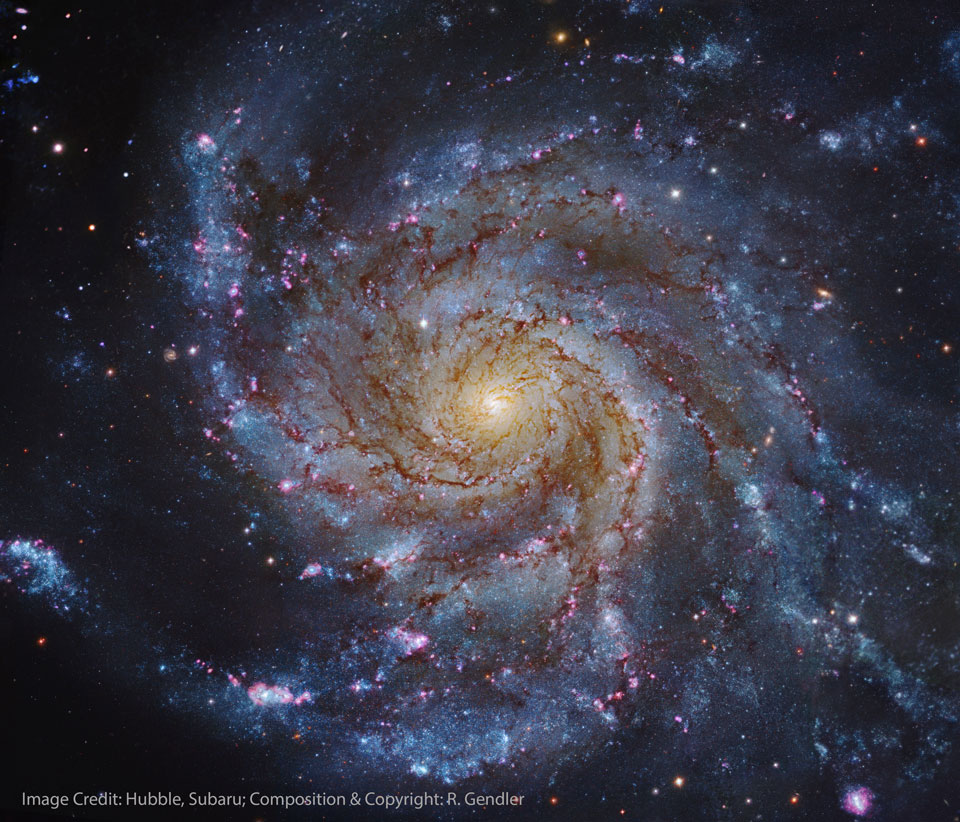
Image of M101 courtesy of APOD 2015 June 14
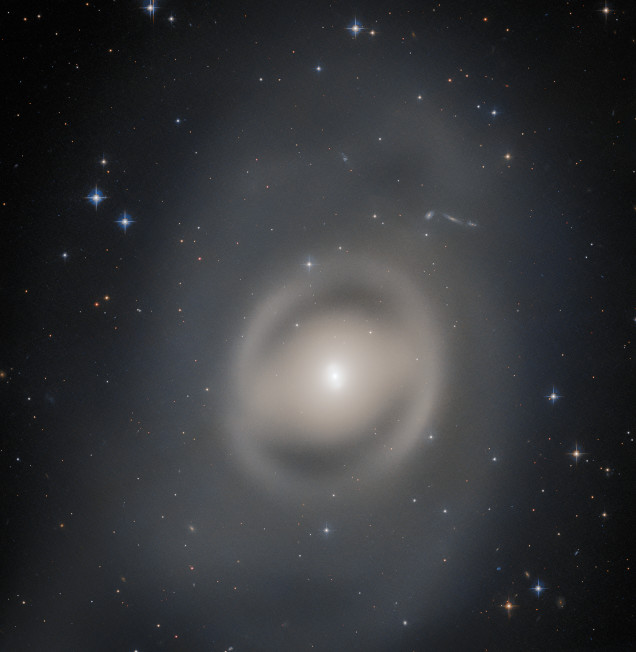
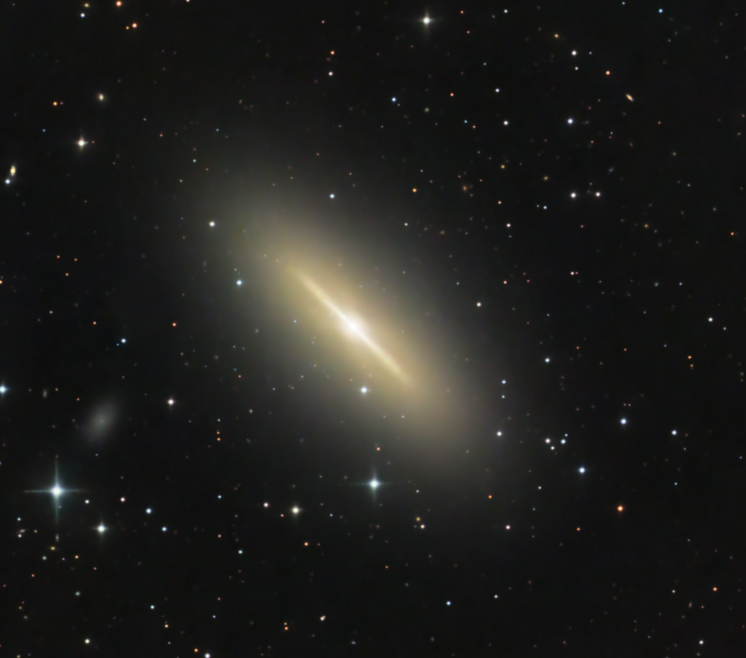
Image of NGC NGC 6684 courtesy of ESA/Hubble & NASA, R. Tully. Image of NGC 3115 courtesy of Telescope Live
 Copyright © Michael Richmond.
This work is licensed under a Creative Commons License.
Copyright © Michael Richmond.
This work is licensed under a Creative Commons License.
Let's look at the gross properties of galaxies from several different points of view. As you'll see, they often seem to split up into distinct groups, which correspond pretty well to the simple split between spirals and ellipticals.
There are a number of differences in the makeup of spiral and elliptical galaxies. To a very rough approximation, we can list the ingredients of each type as follows.
Spiral Elliptical
------------------------------------------------------------------------
lots of gas and dust little gas and dust
ongoing star formation no more star formation
some hot young stars few hot young stars
not so many older stars mostly older stars
elliptical central bulge elliptical entire galaxy
flattened disk of gas no disk
extended faint halo extended faint halo
stars mostly rotating one way stars in randomly oriented orbits
------------------------------------------------------------------------
This is an over-simplification, of course. There are many exceptions to the rules listed above; plenty of elliptical galaxies do show signs of gas and dust, for example. Nonetheless, it is useful to keep these differences in mind.
Why do galaxies fall into these two main types? One of the main reasons is age. If we were to record the life of a typical galaxy with just a few events, it might look something like this:



... but what about the ellipticals?
One theory for the origin of elliptical galaxies involves the collision and merger of two or more spiral (or elliptical) galaxies. The intense gravitational forces during the merger can cause some of the gas to undergo a burst of star formation, and the rest of the gas to be ejected into intergalactic space; moreover, the spiral structure is disrupted during the collision, leaving a featureless elliptical collection of stars behind.
(Click on the picture below to watch a movie of such a collision)
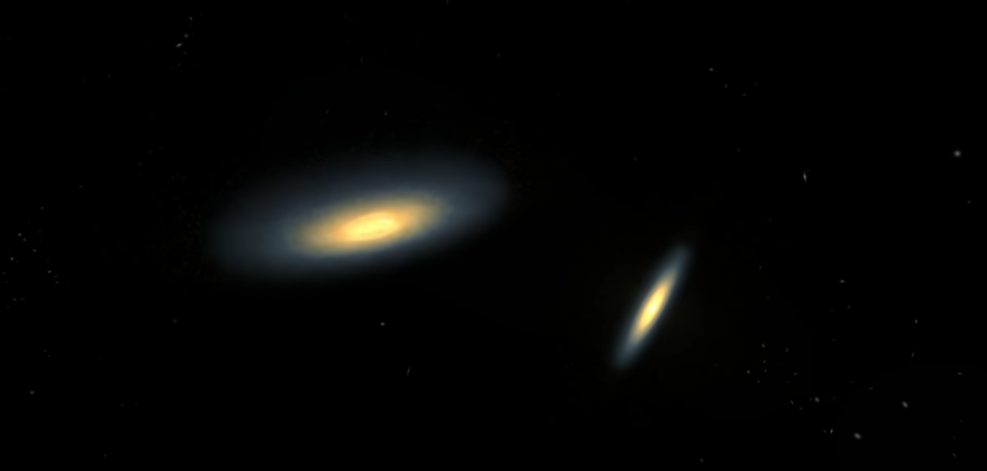
Movie of colliding spiral galaxies courtesy of
NCSA/NASA/B. Robertson (Caltech) and L. Hernquist (Harvard Univ.)
Large surveys of galaxies have found many examples of the distorted spirals formed in the midst of such collisions.

Image and movie courtesy of
VISUALIZATION: Frank Summers; SIMULATION: Chris Mihos (CWRU), Lars Hernquist (Harvard)
Not all galaxies are close enough, or bright enough, that we can take detailed pictures of them. Fortunately, there are a number of other ways that we can separate spirals and ellipticals, even without high-resolution photographs.
One of the simplest ways to classify galaxies is to measure their colors: just add up all the light in two different passbands and compare the magnitudes in each. For small, distant, and faint objects, this may be one of the few practical measurements.
A good reference for this sort of work is Strateva et al. AJ 122, 1861 (2001) , which used a set of almost 150,000 galaxies measured with the SDSS. The authors find that galaxies naturally fall into two groups based on optical colors. Moreover, the two groups -- based on colors -- are almost the same as the groups one would find based on spectral type

Figure 6a taken from
Strateva et al. AJ 122, 1861 (2001) ,
.... and the same as one would find based on morphology
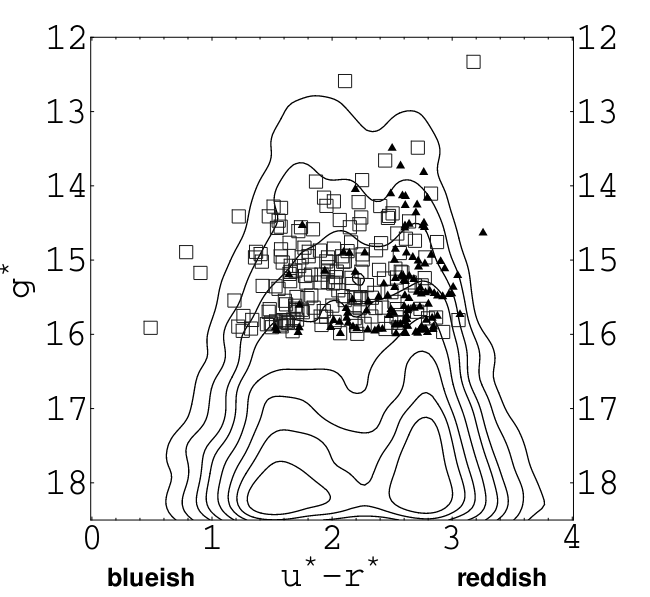
Figure 6b taken from
Strateva et al. AJ 122, 1861 (2001) ,
Here's a more detailed breakdown of the galaxies by their morphological type; again, note how well morphology agrees with color.

Remember concentration index? Well, the degree to which light is concentrated in the center also correlates well with overall color.
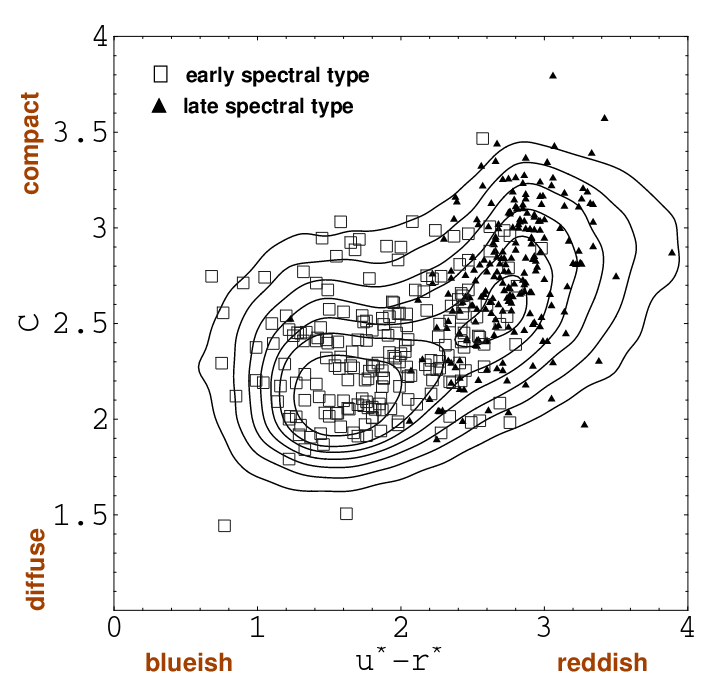
Figure 8b taken from
Strateva et al. AJ 122, 1861 (2001) ,
Of course, a VERY simple way to check this connection between color and galaxy type is to look at a big picture full of galaxies and see which ones are red and which ones are blue.
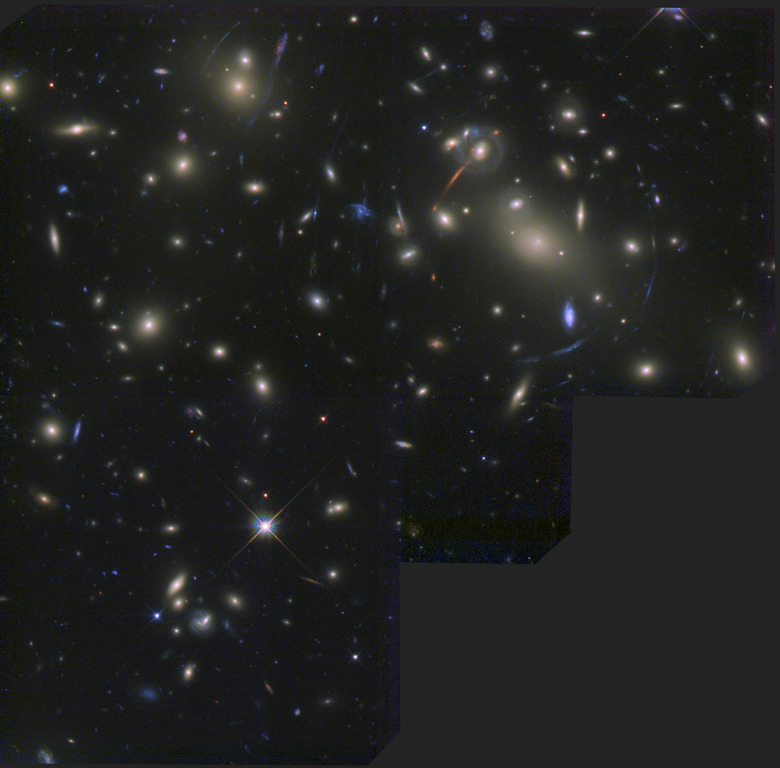
Image of Abell 2218 courtesy of
Andy Fruchter ,
STScI ,
WFPC/2 ,
HST ,
NASA ,
and
Al Kelly.
Speaking of colors, you may hear the term red ridge when someone is discussing clusters of galaxies. As we will see, rich clusters of galaxies have large populations of ellipticals, and the colors of these ellipticals tend to be the same for both high- and low-luminosity members -- just look at the picture above. So, if you happen to make a graph showing color as a function of magnitude, you might see a pattern like this:
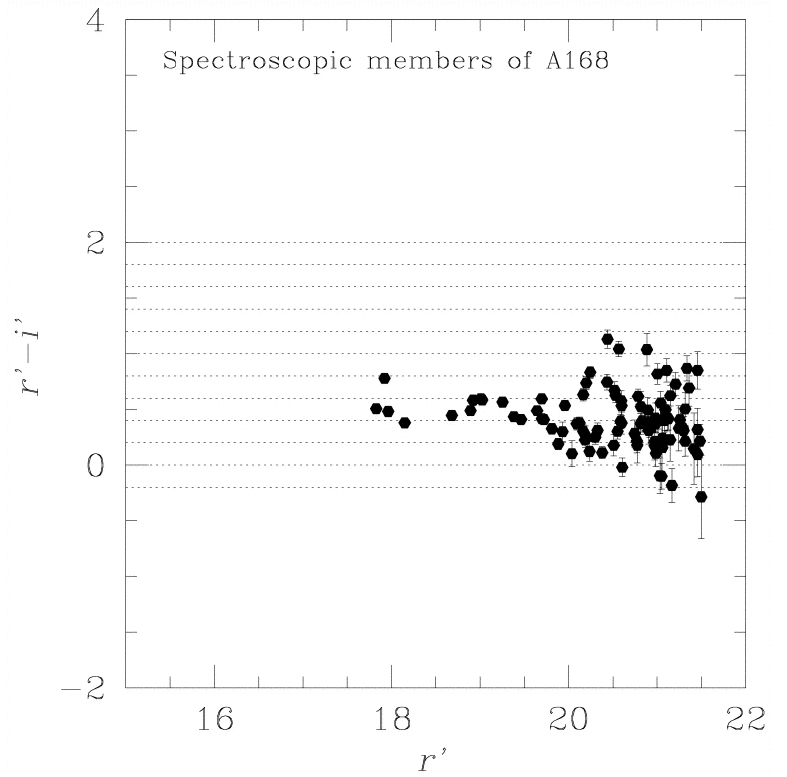
Graph taken from
Goto et al. AJ, 123, 1807 (2002)
Why is it that elliptical (early-type) galaxies have different colors than spiral (late-type) galaxies?
Q: Why are the colors different?
So, below are two sample spectra. Can you tell which one belongs to an elliptical galaxy, and which to a spiral galaxy?

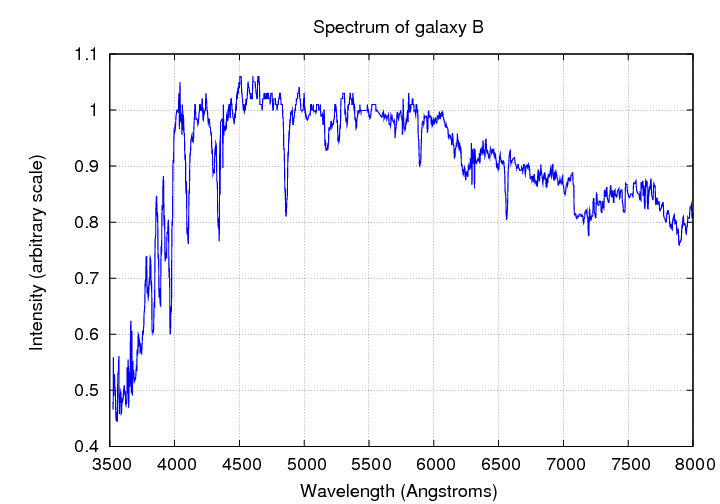
Q: What is the type of galaxy A?
What is the type of galaxy B?
When I hear the word "galaxy", I think of a big whitish ball of stars; after all, that's what one typically sees when one takes a picture. In the optical, stars emit most of the radiation from (most) galaxies.
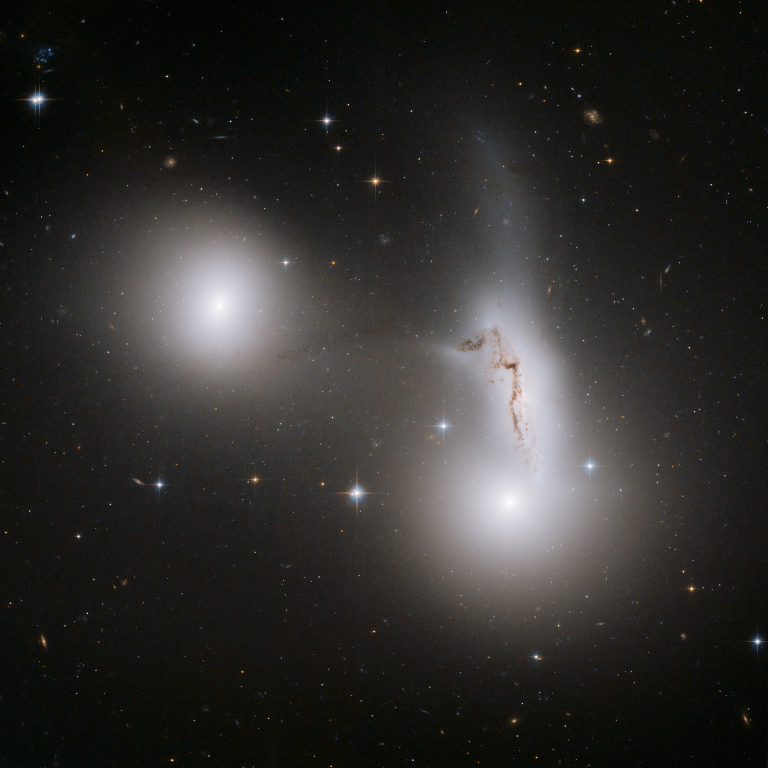
Image of Hickson group 90 courtesy of
NASA ,
ESA ,
R. Sharples
and
Astronomy Picture of the Day
But galaxies change their appearance drastically when observed at different wavelengths. Notice the change as one moves over the relatively small range from near-UV to near-IR: this is just a matter of emphasizing different populations of stars.
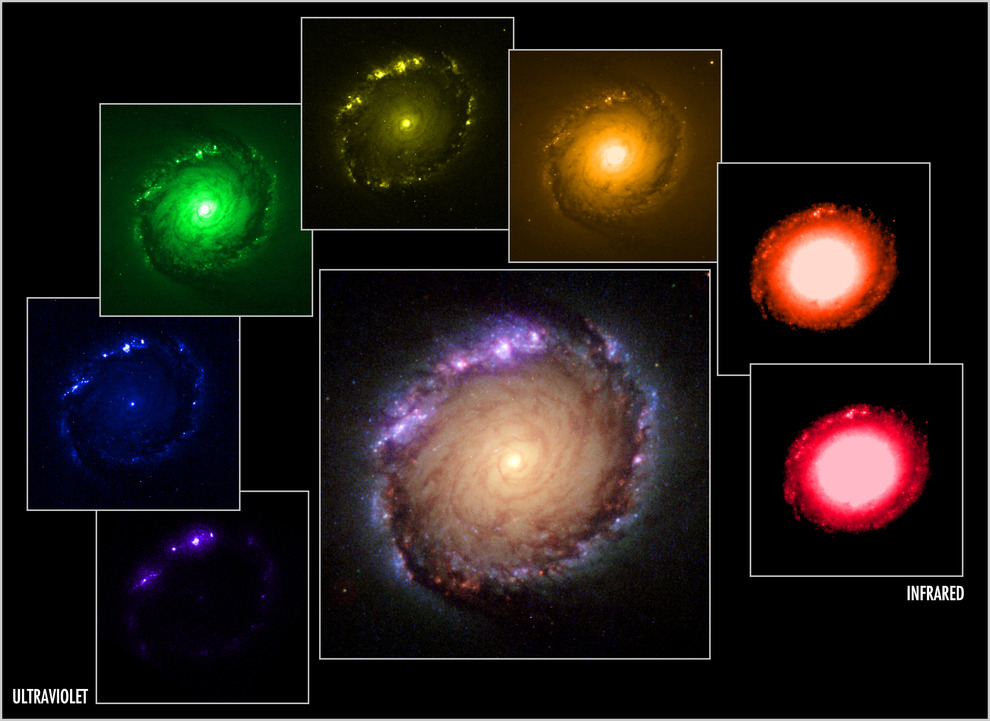
Image of
NGC 1512 courtesy of
NASA ,
ESA ,
and Dan Maoz.
But if one moves farther away from the optical, one discovers that the appearance of galaxies can change drastically.
Here's an elliptical galaxy observed in the X-ray, optical, and radio.
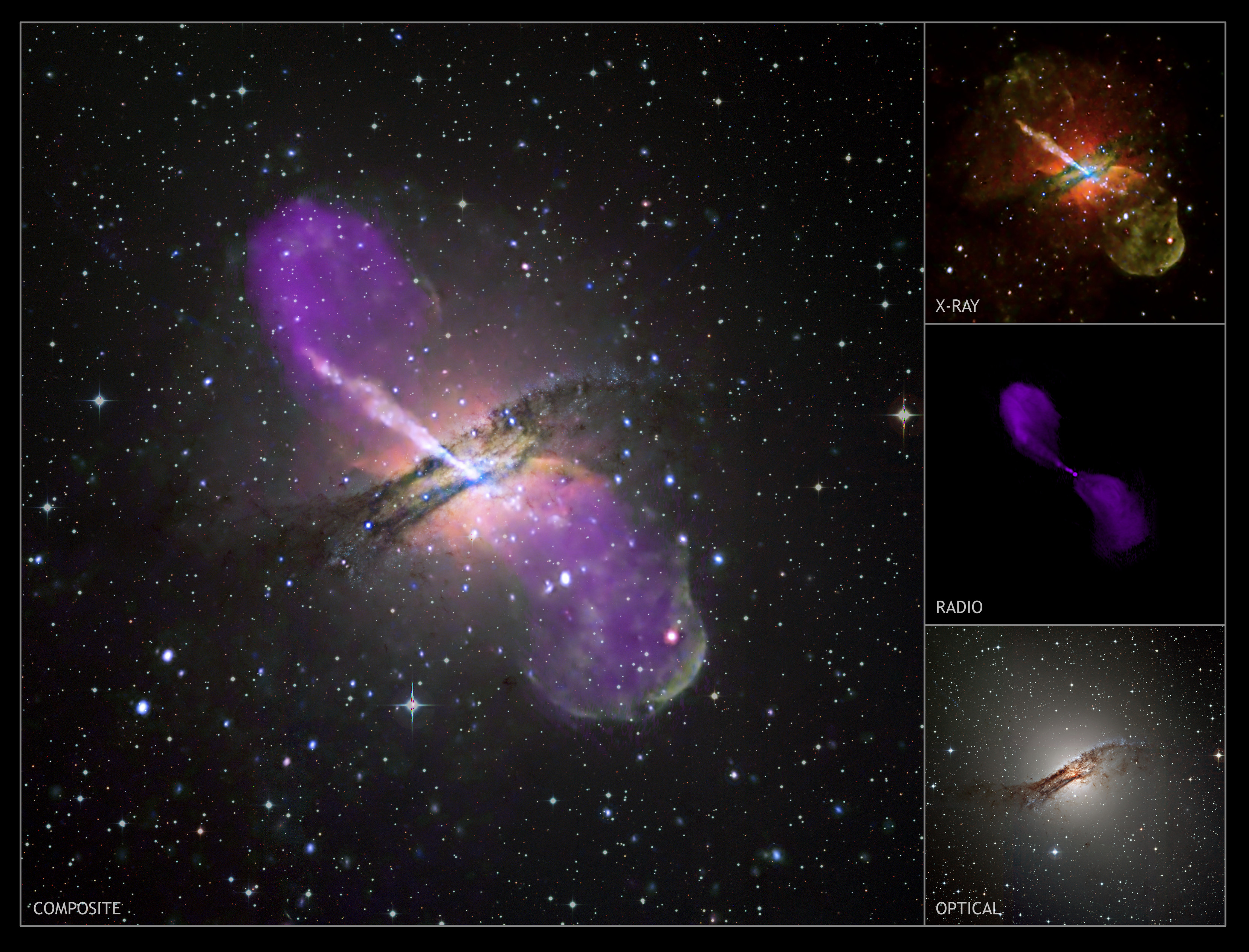
Images of
Centaurus A
courtesy of
NASA ,
and
R. Kraft et al.,
NSF/VLA and Martin Hardcastle,
ESO/WFI and M. Rejkuba et al.
Q: What is the source of the optical light?
What is the source of the radio emission?
What is the source of the X-ray emission?
Here's another multiwavelength view, this time of the interactive pair of spiral galaxies known as the Antennae . The image below is a composite of optical (gold and brown), X-ray (blue) and mid-infrared (red). Click on the figure to watch a brief movie.

Image of Antennae courtesy of
NASA and STScI,
Chandra Center and DePasquale,
Spitzer and JPL/CalTech.
A copy of the
movie in mp4 format.
Q: What is the source of the optical light?
What is the source of the infrared emission?
What is the source of the X-ray emission?
We know that there are many more feeble galaxies than powerful ones. But is the relative number of feeble-versus-powerful the same for all galaxies, or does some group tend to have more 97-pound weaklings?
The answer is -- no, not all galaxies share the same ratio of weak to monstrous. In clusters, at least, elliptical galaxies provide most of the high-luminosity members, while spirals dominate at the feeble end. The two figures below show the same general behavior, whether one separates galaxies into late-type and early-type using concentration index ....

Figure 3c taken from
Goto et al. PASJ, 54, 515 (2002)
and slightly modified
... or color.
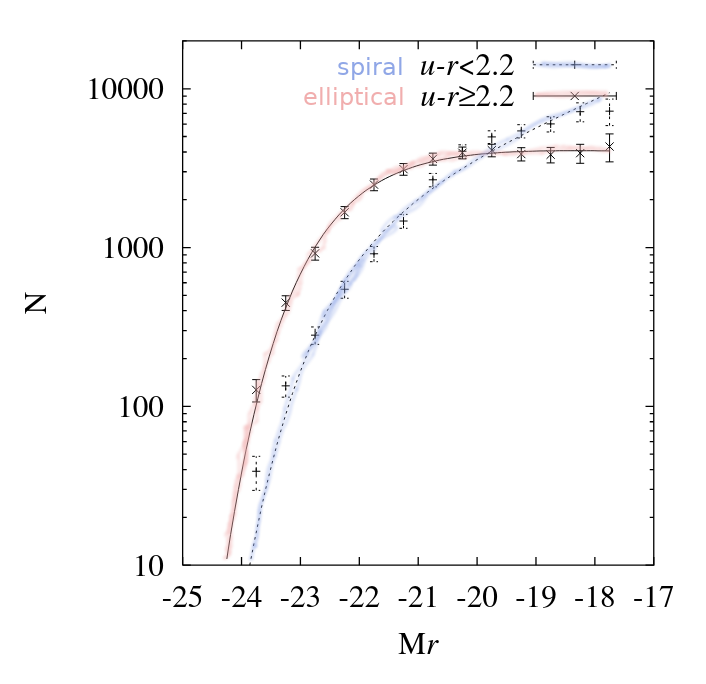
Figure taken from
Goto et al. PASJ, 54, 515 (2002)
and slightly modified
What sort of galaxies are the most common? It turns out that the answer to that question depends on where you are looking. If you look in the "field" -- that is, at some random area of the sky where galaxies are scattered at random -- you will find a preponderance of late-type galaxies. But if you focus your attention near a rich cluster, you will find more early-type galaxies.
One way to quantify this is to compute the local density of galaxies in many different places, and then examine the fraction of early-type and late-type galaxies as a function of the local density. The results are pretty clear:

Figure taken from
Goto et al. MNRAS 346, 601 (2003)
There's a twist to this familiar tale that clusters of galaxies are dominated by ellipticals. If one examines clusters at low and high redshifts, one will find that the high-redshift clusters have more spirals -- or late-type galaxies, anyway -- than the low-redshift clusters. This is known as the Butcher-Oemler effect.
In the figure below, there are four panels. Each one measures the fraction of late-type (spiralish, blueish, diffuseish) galaxies in clusters as a function of redshift. The four panels correspond to four methods of identifying late-type galaxies:

Figure taken from
Goto et al. PASJ 55, 739 (2003)
Astronomers have written a lot about galaxies over the past few centuries .... a LOT. We've created innumerable names and terms and acronyms to describe and classify and sort galaxies into useful groups.
Can I come up with at least one item of galaxy jargon starting with each letter of the alphabet? As a challenge, I won't look anything up in books or websites, but try only to remember things stuffed somewhere deep in my brain.
 Copyright © Michael Richmond.
This work is licensed under a Creative Commons License.
Copyright © Michael Richmond.
This work is licensed under a Creative Commons License.